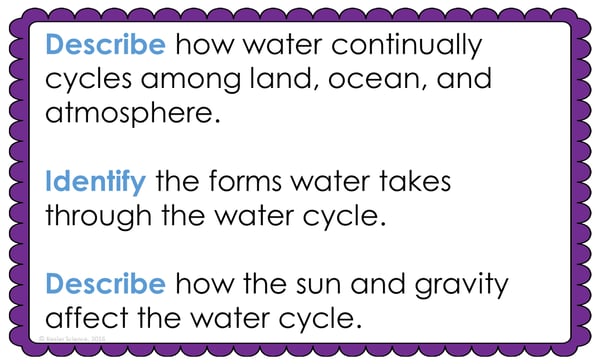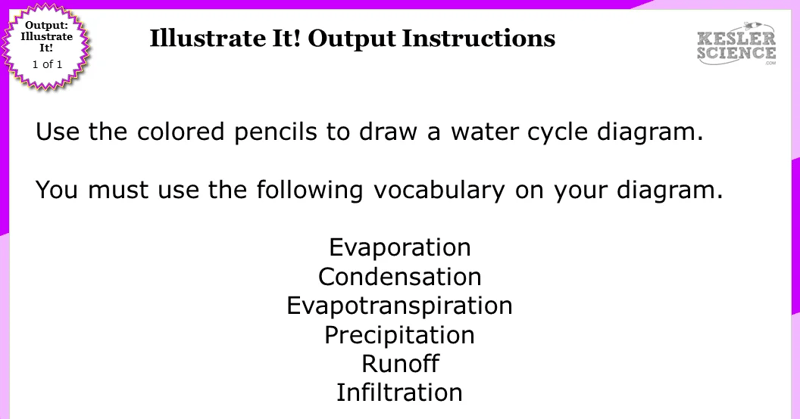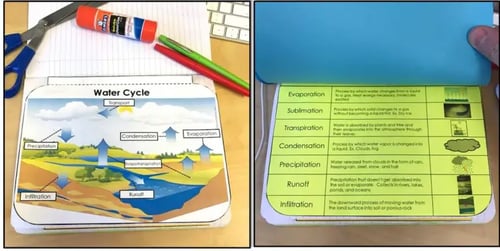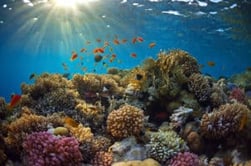Water Cycle Lesson Plan – A Complete Science Unit Using the 5E Method of Instruction
By the end of this lesson about the water cycle, students will be able to describe how water continually cycles between the land, seas, and atmosphere. They will also be able to identify the forms water takes throughout the water cycle and describe how the Sun’s energy and gravity affect the water cycle. Each of our lessons is designed using the 5E method of instruction to ensure maximum comprehension by the students. This well-thought out unit does the heavy lifting, giving teachers easy-to-implement, highly engaging lesson plans.
The blog below will walk you through each of the steps and activities from the Water Cycle 5E Lesson Plan.
ENGAGEMENT
Objective Introduction
At the beginning of the lesson, the class will do a Think-Pair-Share to discuss the objective.
Class Activity
Ask students to make a list of vocabulary words that describe parts of the water cycle while they watch the video using the provided link.
Student Activity
- After watching the video, ask students to make a simple sketch of the water cycle.
- Allow them to work in groups of three or four.
- Each student should produce their own diagram of the water cycle.
- Have students label the parts of the water cycle using the list of vocabulary words they came up with while watching the video.
- Discuss the vocabulary words with them to determine which words they do not understand or that may be new to them.

Afterwards, the teacher will help to clear up any misconceptions their students may have about the water cycle. A common but major misconception, for example, is that water only evaporates from oceans or lakes. Water can evaporate from plants, animals, puddles, and the ground in addition to large bodies of water like oceans and lakes. Students may also believe that water can be created and destroyed.
Estimated Class Time for the Engagement: 20-30 minutes
EXPLORATION
Our student-led lab stations are differentiated for all learners and learning styles. With nine stations in total, you can introduce the water cycle to your middle school students in a variety of ways! Four of these stations are considered input stations where students will learn new information about the water cycle, and four of the stations are output stations where students will be demonstrating their mastery of the lesson's material. A bonus station offers challenges for your early finishers and independent learners. You can read more about how I set up the station labs here.
Watch It!
At this station, students will watch a short video explaining the water cycle. Students will then answer questions related to the video and record their answers on their lab station sheet or on the interactive slides. For example: Explain the term precipitation and provide three examples.
Read It!
This station will provide students with a one-page reading about the water cycle. There are four follow-up questions that the students will answer to demonstrate their comprehension of the reading material.
Explore It!
Students will work in pairs to better understand the water cycle. In this station, students will be operating a hot plate and a beaker of water and observe the elements of the water cycle right before their goggle covered eyes (safety first!). Students will follow the steps and record their observations on their lab sheet. Virtual students will watch a simulation and make observations on their interactive slides.
Research It!
The research station allows students to explore an interactive webpage where students take a scientific approach to understanding the water cycle. Students complete a few tasks and record answers on their lab sheets or interactive slides.
Organize It!
Students at this station match vocabulary words and descriptions using a paper card set or the interactive slides. Once students have completed their organization, the teacher will check their understanding.
Illustrate It!
Your visual students will love this station. Students are to create a labeled diagram of their interpretation of the water cycle, incorporating major vocabulary from the unit. Virtual students may draw and upload their diagrams.

Write It!
Students who are able to answer open-ended questions about the content truly understand the concepts that are being taught. At this station, students will be answering three questions. For example: Describe the water cycle process starting from an afternoon thunderstorm.
Assess It!
The Assess It station is where students prove mastery over the lab concepts. The questions are set up in a standardized multiple-choice format.
Challenge It! - Bonus Station
Early finishers and advanced students will love the extension activities in this station. Four activity choices offer them ways to expand their learning through mini-games and mini-projects.
Estimated Class Time for the Exploration: One or two 45-minute class periods
EXPLANATION
The explanation activities will become much more engaging for the class once they have completed the exploration station lab. During the explanation piece of the lesson, the teacher will be clearing up any misconceptions their students may have about the water cycle with a variety of materials. These materials include on-level and modified versions of the interactive presentation (may be used individually or projected), anchor charts, and paper or digital interactive notebook activities. If you have students that need modified notes, the 5E lessons come equipped to help give every student access to the lesson.

Interactive notebook samples: Above-left is a digital INB activity slide; above-right is an example of the paper INB activities.
Estimated Class Time for the Exploration: Two or three 45-minute class periods
ELABORATION
The elaboration section of the 5E method of instruction gives students choices that allow them to prove they’ve mastered the concepts behind the lesson. When students are given a choice, they’re much more enthusiastic and invested in the project than they are when their teachers choose their projects for them. There are a total of nine choices to demonstrate understanding of the water cycle. A separate set of choices that offer more teacher support are also available for students that need them. Rubrics guide students to doing their best work and assist in grading.

Estimated Class Time for the Elaboration: Two to three 45-minute class periods (can also be used as an at-home project)
EVALUATION
The final piece of the 5E model is an evaluation of your students' comprehension. This unit includes a homework assignment, an on-level assessment, and a modified assessment. Research has shown that homework needs to be meaningful and applicable to real-world activities in order to be effective. When possible, I like to give open-ended assessments to truly gauge the student’s comprehension.
Estimated Class Time for the Elaboration: One 45-minute class period
Download the Full Lesson Now!
Download Over $100 in FREE Resources
For Middle School Science
Simply create a login below and gain immediate access to a selection of our Kesler Science product line worth $100 - for FREE. There's a full version of every product type! You'll also join tens of thousands of middle school science teachers who receive timely tips and strategies straight to their inbox.


.png?width=800&height=120&name=Blog%20Banners%20to%20TPT%20for%205E%20Lessons%20(1).png)




